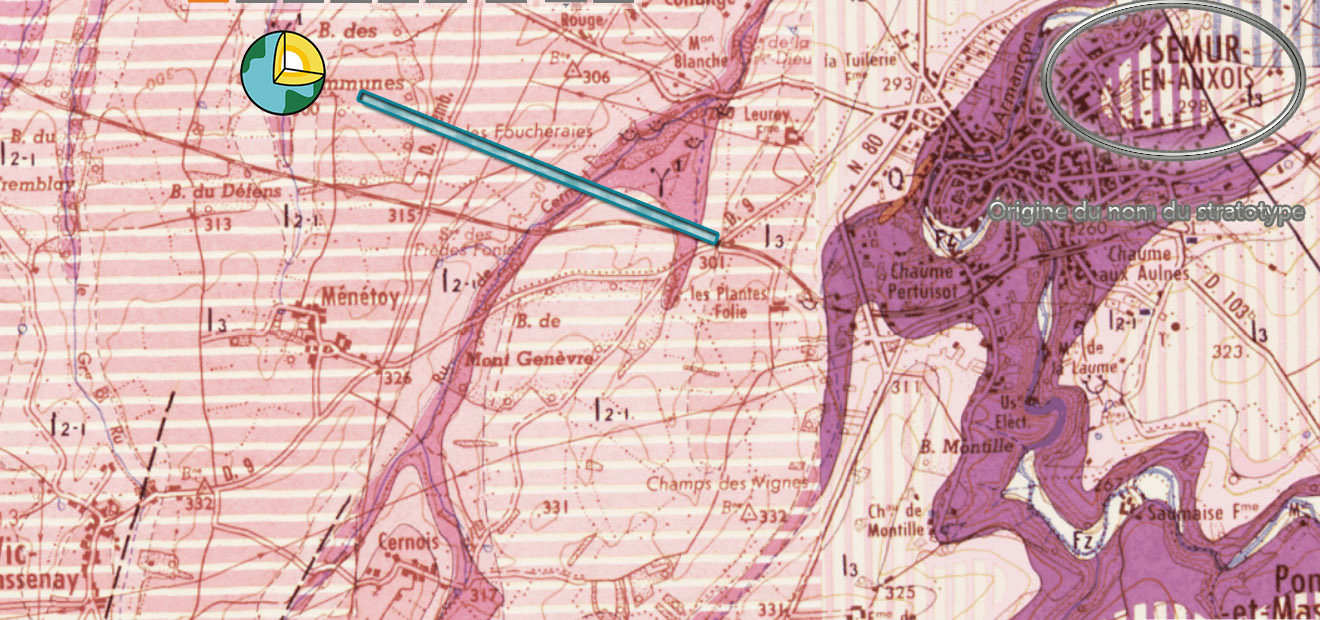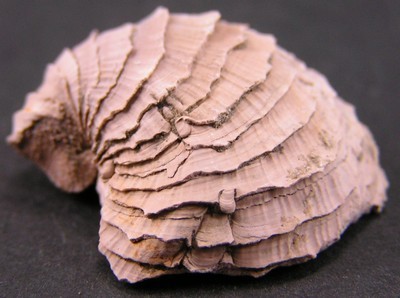Le Stratotype historique du Sinémurien
The historic Stratotype Sinemurian


FRA
Définition
Le stratotype d'une unité stratigraphique, un étage en l'occurence, est une coupe type qui sert en quelque sorte d'étalon, de référence, pour la définition et l'identification de l'unité, grâce à ses fossiles en particulier.
Historique
Particularité ici, Alcide d'Orbigny, qui définit l'étage Sinémurien en 1849, n a ps donné de coupe-type car sa définition reposait en fait sur des fossiles recueillis en différents points.
Il declara : « J'ai fait dériver ce nom de la Ville de Semur (Sinemurium) où se trouve le meilleur type, un gisement que je puis regarder comme étalon, c'est à dire pouvant toujours servir de point de comparaison. C'est la zone de l'Ostrea arcuata et de l'Ammonites bisulcatus. Je connais jusqu »à présent 175 espèces.. »

Ammnonites bisulcatus
Les premières descriptions détaillées de coupes qui aient été considérées comme faisant partie du stratotype ont été données par R. Mouterde en 1951.
Notamment figure la coupe de la tranchée de la voie ferrée de Semur à Avallon, au passage à niveau de la route de Semur à Vic de Chassenay. D'autres coupes ont été necessaire pour donner une description complète du stratotype.
Faune
Nombreux invertebrés benthiques : gryphées arquées et autres lamellibranches, gastropodes, brachiopodesn échinodermes, qui sont de très bon indicateurs d'une salinité marine normale( articles de pentacrines), fouisseurs indeterminés.. Amnonite, fragments de bélemmites.

Ostrea arcuata
Structure
Des bancs calcaires très durs, très compacts alternent avec des couches plus argileuses, plus ou moins litées. Leur surface, aussi bien en haut qu'en bas, est très capricieuse, avec souvent des gryphées en saillie.
Aucune structure ou figure de sedimentation n est evidente mais les bancs montrent de belles traces de bioturbation. Ce qui explique leur homogénéité.
Le milieu de genèse
Un fond marin calme (près de la moitié des gryphées auraient gardé leur position de vie) mais non très profond, une sediementation lente ; des eaux de salinité normale.

Organisation sédimentaire et diagénétique du Calcaire à Gryphées
A gauche : Alternance de bancs calcaires compacts aux surfaces tourmentés ou d alignements de miches de même nature, et de niveau plus argileux
A Surface inférieure du banc. Deux coquilles de gryphées ont été mises en saillie vraissembablement par la dissolution diagénétique d'une partie du banc calcaire. L'une, à gauche est restée en position de vie ; l'autre a basculé
B Partie du banc montrant de nombreux terriers verticaux à remplissage sombre ( à l'origine une boue calcaire à bioclastes) et de niveaux de dissolution (d)
C Passage vertical et horizontal du calcaire compact gris bleu enrichi (1) en calcite par cimentation complémentaire aux horizons feuilletés (3) partiellement décalcifiés avec une zone intermédiaire (2) encore cohérente mais légèrement poreuse, oxydée en jaune, à bioclastes orientés
Rappel concernant les « Earthcaches »: Il n'y a pas de conteneur à rechercher ni de logbook à renseigner. Il suffit de se rendre sur les lieux et d'exécuter les requêtes du geocacheur
Loguez cette cache "Found it" et envoyez-moi vos propositions de réponses soit via mon profil, soit via la messagerie geocaching.com (Message Center), et je vous contacterai en cas de problème.
Il est aussi apprecié d'avoir des photos des geocacheurs sur lesles lieux des EarthCache. Sentez vous inspiré de poster des photos de vous lors de cette visite ( optionnelle mais sympa)
EN
The historic Stratotype Sinemurian
Definition
The stratotype of a stratigraphic unit, one floor in this case, is a type of cut that serves as a kind of standard of reference for the definition and identification of the unit, with its fossils in particular.
Historical
Feature here, Alcide d'Orbigny, which sets the stage Sinemurian in 1849 n ps has given cut-type because its definition was in fact based on fossils collected at different points.
He declared: "I made derive the name of the city of Semur (Sinemurium) where is the best kind, a field that I can look like standard, that is, still can serve as a point of comparison. This is the area of Ostrea arcuata and bisulcatus Ammon. I know up "now 175 species .."
The first detailed descriptions of cuts which were considered part of the type section were given by R. Mouterde in 1951.
Figure including cutting the trench of the railway from Semur in Avallon, at the crossing of the road from Semur in Vic de Chassenay. Other cuts were necessary to give a full description of the stratotype.
 Ammnonites bisulcatus
Wildlife
Many benthic invertebrates: gryphées arched and other bivalves, gastropods, echinoderms brachiopodesn, which are good indicators of normal marine salinity (articles pentacrines), burrowing indeterminate .. Amnonite, fragments bélemmites.
Ammnonites bisulcatus
Wildlife
Many benthic invertebrates: gryphées arched and other bivalves, gastropods, echinoderms brachiopodesn, which are good indicators of normal marine salinity (articles pentacrines), burrowing indeterminate .. Amnonite, fragments bélemmites.
 Ostrea arcuata
Structure
Very hard limestone beds, very compact alternate with layers of clay, more or less layered. Their surface, both above and below, is very capricious, often with gryphées protruding.
No structure or figure sedimentation n is obvious but the benches beautiful show traces of bioturbation. This explains their homogeneity.
The genesis of the middle
A calm sea floor (almost half of gryphées have kept their position in life), but not very deep, slow sediementation; normal salinity of the water.
Ostrea arcuata
Structure
Very hard limestone beds, very compact alternate with layers of clay, more or less layered. Their surface, both above and below, is very capricious, often with gryphées protruding.
No structure or figure sedimentation n is obvious but the benches beautiful show traces of bioturbation. This explains their homogeneity.
The genesis of the middle
A calm sea floor (almost half of gryphées have kept their position in life), but not very deep, slow sediementation; normal salinity of the water.

Sedimentary and diagenetic Organization Limestone Gryphées
Left: A mix of compact limestone beds with tormented surfaces or similar loaves of alignments, and more clay level
A lower surface of the bench. Gryphées two shells have been projecting vraissembablement by diagenetic dissolution of part of the limestone bed. The one on the left has remained alive position; the other rocked
B Part of bench showing many vertical burrows dark filling (originally a limestone slurry bioclastes) and dissolution levels (d)
C vertical and horizontal passage compact rich blue gray limestone (1) Calcite by supplementary cementing the laminated horizons (3) partially decalcified with an intermediate zone (2) still consistent but slightly porous, oxidized yellow oriented bioclastes
Reminder concerning "Earthcaches": there is neither a container to look for nor a logbook to sign.
Log in this cache " Found it " and send me your answers proposals or via my profile or via geocaching.com messaging (Message Center ) , and I will contact you in case of problems .
I also enjoy seeing photographs of people visiting this EarthCache. Please feel free to log photos of your visit...(this is entirely optional but funny)
Sources :
http://awr.free.fr/FossilCollection/IndexVisual.shtml
crioceratites.free.fr
http://infoterre.brgm.fr/
http://www.bourgogne-nature.fr/fichiers/bn12-106-117-ammonites-sinemuriennes_1390843191.pdf
Questions :
FRA
1 - Qu est ce qu un stratotype ?
2 - Quelle difference de construction a ce stratotype avec d'autres comme le cenomanien
3 - Observer les alentours. Voyez vous beaucoup de dénivelés ?
4 - Comment est le « materiel » qui affleure ?
5 - (Facultatif mais recommandé) Une photo ?
EN
1 - That is that a stratotype?
2 - What difference has this building stratotype with others like the Cenomanian , ?
3 - Observe the surroundings. You see a lot of elevation changes?
4 - How is the "material" that flush?
5 - (Optional but hightly recommended) A photo?
Joyeux et Happy Earthcaching